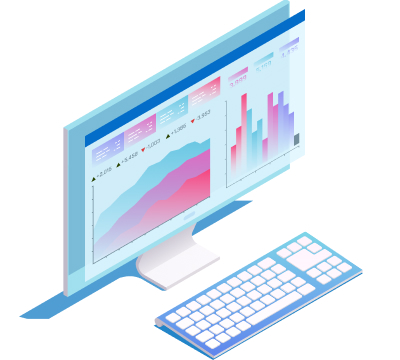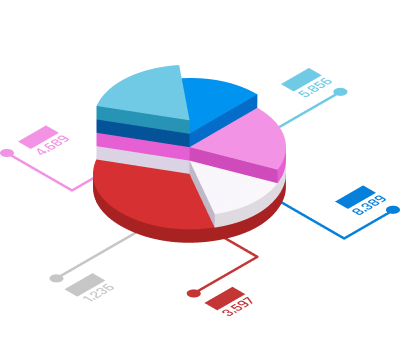If you are getting started on stock trading or investing, there are various elements that you should be aware of. First, you must learn what stock trading is and how to choose the right stocks with profit potential. Understanding what stock charts are and how to read them is also vital for developing the best trading strategy.
Fortunately, we have prepared this guide for you, which entails the basic information on stock charts. Beginners will fully benefit from this, thereby getting off their trading venture to a good start. Simply put, learning how to analyse stock charts will make stock trading and investing more straightforward.
In This Article
Meaning of a Stock Chart

A stock chart is like a table or graph that displays a company’s stock information on price history, trading volume, dividends, and other financial information. Having a visual representation of a stock price action allows you to quickly identify price patterns, especially the most common and rare ones to apply in your trading strategy.
Stock charts are used in technical analysis, where they help traders map out stock price history to identify the best entry and exit points. Here are the key information included in a stock chart.
- A stock’s symbol and the exchange market they trade on.
- The stock chart period, which is usually daily, weekly, monthly, quarterly, or yearly. You will choose a chart period based on the price movement you are willing to forecast — either long-term or short-term price movements.
- Price change, which shows the stock’s prices at the beginning and end of a chart period. It also shows the highest and the lowest price during the session.
- Previous stock price changes. For instance, on a daily chart, you will be able to view the last day’s price performance.
- The number of stocks or trading volume in a particular period. High volume means that more traders and investors are participating in trading the stock, while low volume means that the trend may not continue in the long run since few people are participating.
Types of Stock Charts
Stock charts are constructed in different forms, including candlestick, bar, point and figure, and line charts. You can choose based on the information you seek in a short-term or long-term position. Take a look below.
The line chart is the most commonly used stock chart for tracking stock’s closing prices within a specified period. On a chart, you will see closing prices represented by dots, which are later joined by lines to complete the graphical representation.
The main goal of a line chart in stock trading is to identify price movement trends. However, since it only tracks the closing prices, you must be keen when using this trend in getting information regarding day trading price movements.
Bar charts and line charts are pretty similar, but the bar chart provides more information. Its representation on a graph is shown using a vertical line, with the top part representing the highest price of stock traded for a single day while the bottom side represents the lowest price.
Furthermore, two horizontal lines extend from each side of the central vertical line. The line extending from the left represents the stock’s price when it opened, whereas the one extending from the right shows the stock price when the stock closed on a given day.
The best thing about bar charts is that you get clear insights on market volatility, thereby taking advantage of opportunities as they arise. You can quickly identify where there is high volatility by checking the length of a line — usually longer.
As the name says, candlestick charts represent the price movement of stocks in the shape of a candlestick. Like the bar charts, candlestick charts also show four data points, i.e. high, low, open, and close.
In a graph, the candlestick can either rise or fall, meaning that an extension to the upper direction indicates the rising price, whereas the opposite shows the falling price. Also, when the candlestick body turns green or white, it shows an increase in a stock’s price, whereas red or black indicates a price decrease.
This stock chart also shows market volatility, but unlike the bar chart that displays information for a single day, candlestick charts offer information for a more extended period.
Point and figure charts are also commonly used in stock trading during technical analysis. The chart consists of two columns, X and O. Each of these columns represent price movements in that the Xs show the rising price and the Os show the falling prices of a stock.
The price boxes in this chart are each represented by a specific value that price should reach to guarantee and X or O. Note that the graph will keep evolving as the price changes, meaning that you do not have much time when analysing the point and figure charts. If you see that there is no movement in the chart, it simply shows that the prices aren’t moving either.
The above four types of stock charts are the most commonly used by traders. We advise you to practise using them using stock broker’s demo accounts by opening and closing positions based on the signals they provide. Then, once you get confident with your capabilities, you can open a live trading account and use them to create the best trading strategy for profit.
Stock charts will help you quickly predict price trends, and when used correctly, they can be one of the best tools to earn you profits. Also, consider using multiple charts to be sure of your analysis rather than sticking to only one.
Read about How to Invest in Stocks UK in our other guide for more detailed information.
How to Read Stock Charts

Understanding the meaning and type of stock charts is not beneficial if you do not know how to analyse them. In stock charts, there is a common term known as charting or plot lines, which usually represent a stock’s price movements.
The more you become more familiar with stock charts, you will also be able to customise them to different time frames that suit your investment plan. However, as a beginner, here are a few tips to get you started.
- Observe Price and Period Axes
A stock chart has two sides being the price and the time period axes. The horizontal axis, usually at the bottom of the chart, mostly represents the time period selected. It can be easily customised to suit your trading period, whether it’s a day, months or years.
In contrast, the vertical axis indicates the price of a stock. By observing it, you will be able to easily know when there is a price change. As a result, you will make a quick move that benefits your trade.
- Identify the Trend Line
Trend lines are the lines that move up and down in a stock chart. However, depending on the type of stock chart you are using, the trend line will give an accurate overview of how the stock’s price might be in the near future. Examples of stock charts are listed above, so choose the ones that work best for your stock trading strategy.
- Understand the Trading Volumes
It is essential to look into a stock’s trading volume when reading a stock chart. You will find stock volume at the bottom of a graph and what you need to do is look at the spikes in trading volume. As a result, you will be able to identify the volume’s trend, whether it’s rising or falling.
For instance, if trading volume rises on a stock’s fallen price, it might be a sign of strength towards the downward trend and vice versa. However, note that you should not base your strategy on trading volumes only since an increase in volumes can be due to important company news. Simply put, high trading volume will not always correlate with low stock prices. Therefore, make sure you analyse previous trends before making a move.
- Identify Support and Resistance Lines
Support and resistance lines are levels at which stocks stay over a selected period, whether trading up or down. A support line is a price at which a stock doesn’t drop below regardless of any given market signals, whereas a resistance line is a price that a stock doesn’t go above.
The stock prices will always bounce between the support and resistance levels. However, should a price go beyond the resistance line, the previous resistance level becomes the new support level. This also means that stocks are likely to keep going up, which you should take advantage of and make the right moves.
- Identify Dividends and Stock Splits Periods
It’s easy to identify the periods in which a company issued dividends or if there was a stock split by studying the bottom of your stock chart. Paying dividends means that a company’s shareholders are getting a portion of the company’s profits.
Not all companies issue dividends to their shareholders, but the chances are that they will offer stock splits. A stock split is when a company opens up its shares of stock to the public for purchase.
During these two periods, more investors take advantage since stock prices are usually low. This, in return, increases the demand for shares hence a price increase. So, identifying split periods and making quick moves can help you make a purchase while the stock prices are still on the lower side.
Where to Find the Best Stock Trading Tools

Stock trading is challenging, but this can only worsen when you begin your venture by making the wrong decisions. Most traders believe that they are fully prepared once they have learnt what stock trading is and the stock charts to analyse.
Unfortunately, this is not the case without a reliable and suitable stock broker. Finding the best broker comes with its fair share of challenges, but worry not because we also recommend some of the best stock brokers in the UK here on this website.
To summarise everything, the best broker in the UK should be regulated by the Financial Conduct Authority (FCA). You must also confirm all the stocks provided and make sure your budget aligns with their charges and requirements.
Once you have confirmed all the elements, including the trading tools such as stock charts, do not be in a rush to take a plunge. Instead, sign up for a demo account and practise stock trading by analysing the markets using the above stock charts.
Only when you feel confident analysing the charts recommended and are able to create the best strategy should you consider signing up for a live account and try your luck.
Basic Stock Chart Terms
We wouldn’t put our pens down without stating the basic terms you will encounter while analysing stock charts. These are:
- Market Cap: Also shown as “mkt cap” in most stock charts, it means market capitalisation. It measures a company’s size by multiplying the total number of shares in the company by the current share price.
- PE Ratio: Representing the price-to-earnings ratio, it is used to determine whether a stock is undervalued, fairly valued, or overvalued.
- Dividend Yield: This is the amount shareholders or investors in a particular company are likely to receive in dividends. You will find dividend yields expressed as a percentage of the current share price.
- 52-Week High and Low: This shows the highest and lowest prices traded within a period of 52 weeks.
- EPS: Earnings per share indicates the performance of a company, whether good or bad. Using EPS, you can measure a company’s net profit earned per share.
- Ticker Symbol: This symbol is used in stock exchanges to represent a specific stock. For example, Apple is represented by AAPL on NASDAQ. The abbreviations are usually under the ticker column on a stock chart.
- Net Change: This is a stock’s value that was used to close the previous day. If the net change was positive, it means that the stocks will be up for the day and down if the net change is negative.
Conclusion
It’s not easy to predict the future price of stocks, and even professional stock traders to date are still trying to overcome the challenges. However, stock charts can help increase your chances of becoming a successful stock trader or investor. This is especially if you understand what stock market charts are and how to read them. You should also be able to analyse the history of stock market charts in order to forecast future prices.
Not everyone has the capability of studying stock charts since we believe it is a skill. Worry not because this guide will get you off to a good start. You also need to practise more and keep learning everything there is to know about stock trading and investing if you want to succeed. All in all, we wish you the best.
For those interested in penny stock trading, finding the best penny stock trading platform in the UK is crucial. Such a platform should offer access to a wide range of penny stocks, provide reliable tools for analysis, and maintain excellent customer support to support your journey as an investor in this high-risk market segment.






Many of my friends have faced losses with stock trading...
You have a lot to learn and practice. Trading in the stock market is similar to studying at a university. If you want your deal to be successful, you have to practice and learn a lot.